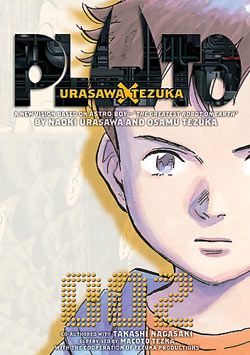One of the first manga series I ever saw was "Pineapple Army," published in flipped floopy format by Viz back in the late 1980s. It obviously wasn't the first manga to penetrate the American direct market, but it was one of the first I had ever seen on the shelves of my local comic shop. And I certainly read it long before I ever read a single page of Osamy Tezuka's "Astro Boy" (a series I was vaguely aware of for decades, but one that I never bothered to read until less than two years ago).
Here, in "Pluto: Urasawa x Tezuka," we get the artist of "Pineapple Army" -- probably more famous to American audiences for his medical thriller "Monster" -- taking one of the most famous "Astro Boy" stories and retelling it in a way only Naoki Urasawa could. It's a decompressed version of what amounted to -- in Tezuka's hands -- a robot battle sequence that stretched out over a hundred pages. Urasawa isn't particularly interested in the battle scenes -- robot on robot action isn't what you'll get in these pages, though he may be building to it in later volumes for all I know -- but what he is interested in is creating a moving, haunting, melancholy, resonant story about a world in which immensely powerful robots drift through a world populated by humans.
Robot detective Gesicht spends the first two volumes of this series investigating the mysterious deaths of some of those robots. In Tezuka's original story, Astro Boy is the star, reacting to the series of events in which one ultra-bad mechanical being beats down one charming robot after another. But by shifting the focus to Gesicht, Urasawa establishes a more ponderous pace, and emphasizes a kind of existential dread that's absent from the juvenile (yet still impressive) Tezuka tale.
It's the shift in focus that makes "Pluto: Urasawa x Tezuka" so powerful. It's probably a silly comparison to make, but as a longtime superhero reader and relative manga neophyte, this series struck me as a kind of "Watchmen" for the manga crowd. It deconstructs the mythic characters of Tezuka's immensely influential "Astro Boy" comics, taking them from cartoonish exaggerations and treating them with a subtle realism. This is softer than "Watchmen," and it's less formally inventive, but it reminds me of the experience I had while reading Alan Moore and Dave Gibbons's work for the first time: "Oh," I thought, "this is certainly a different take on things." And I have that same feeling reading this series.
Volume 2 isn't quite as moving as the first volume, but it's still excellent, as Astro Boy himself -- looking like a more realistically-rendered small boy -- plays a prominent role and becomes drawn deeper into the events Gesicht finds himself investigating. Urasawa also deepens the mystery -- the title character, and villain of the piece, hasn't even appeared yet -- and raises some questions about the relationship between the robots and their human handlers. Gesicht may or may not have been tampered with, and as an investigator, his missing memories are more than an inconvenience.
Though I've read Tezuka's "The Greatest Robot on Earth," I have no particular fondness for it. It's a fun diversion, and it looks great, but there's not much to it. Yet this elaborate, decompressed reimagining of Tezuka's story works on a more sophisticated level. It's the robot battle story you never thought you needed, and it's very good.

